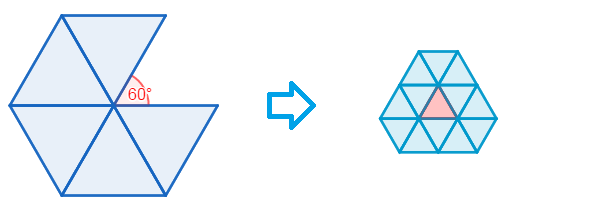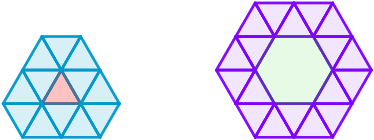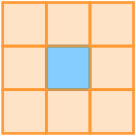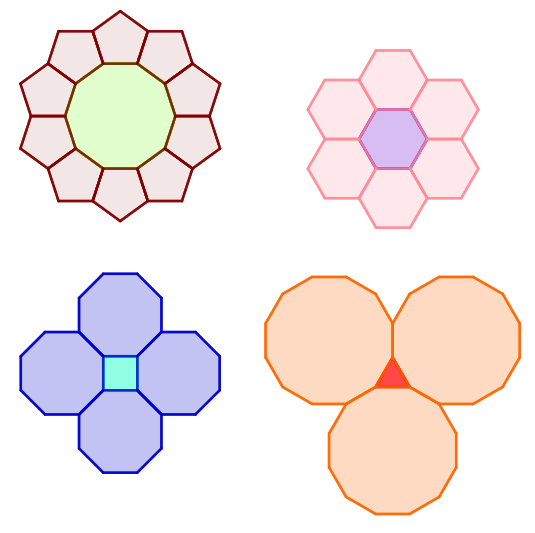Regular n-gon
A regular decagon is obtained by joining 10 regular pentagons side by side.
Generalizing this, we claim that there is a regular n -gon obtained by joining n regular k -gons side by side.
What is the sum of all possible values of k ≥ 5 ?
The answer is 31.
This section requires Javascript.
You are seeing this because something didn't load right. We suggest you, (a) try
refreshing the page, (b) enabling javascript if it is disabled on your browser and,
finally, (c)
loading the
non-javascript version of this page
. We're sorry about the hassle.
4 solutions
Elegant solution!
But doesn't the question mention that we need to place n k-gons to form the n-gon and thus the cases k=12 and k=8 shouldn't qualify.
Log in to reply
What do you mean? You place n=3 regular k=12-gons to make a regular n=3-gon, and you place n=4 regular k=8-gons to make a regular n=4-gon. Both perfectly match your description, where both occurences of n indeed match.
A close observation will make you realise that when we applied the formula for finding the angle, we used the info you are refering to. Doing it practically will verify it.
Despite
k
≥
5
, we can also observe the cases for
k
=
3
and
k
=
4
.
Let
α
and
β
be the internal angles of regular
k
-gon and
n
-gon respectively. Then:
α
=
(
1
−
k
2
)
1
8
0
°
β
=
(
1
−
n
2
)
1
8
0
°
What we are going to do is "glue" multiple regular
k
-gons to form one angle of a regular
n
-gon, and then use that patter
n
times to form the regular
n
-gon. For example, "gluing"
5
equilateral triangles gives us a
6
0
°
angle, which can be used to form another equilateral triangle:
 Now let
x
∈
N
be the number of reuglar
k
-gons glued. Obviously,
x
>
1
.
x
angles of the
k
-gon and an angle of an
n
-gon will add up to
3
6
0
°
, as in the picture above:
β
+
x
α
=
3
6
0
°
As
β
is an angle of a regular polygon, it must satisfy:
6
0
°
≤
β
<
1
8
0
°
So:
6
0
°
≤
β
<
1
8
0
°
6
0
°
≤
3
6
0
°
−
x
α
<
1
8
0
°
−
3
0
0
°
≤
−
x
α
<
−
1
8
0
°
1
8
0
°
<
x
α
≤
3
0
0
°
α
1
8
0
°
<
x
≤
α
3
0
0
°
Now let
x
∈
N
be the number of reuglar
k
-gons glued. Obviously,
x
>
1
.
x
angles of the
k
-gon and an angle of an
n
-gon will add up to
3
6
0
°
, as in the picture above:
β
+
x
α
=
3
6
0
°
As
β
is an angle of a regular polygon, it must satisfy:
6
0
°
≤
β
<
1
8
0
°
So:
6
0
°
≤
β
<
1
8
0
°
6
0
°
≤
3
6
0
°
−
x
α
<
1
8
0
°
−
3
0
0
°
≤
−
x
α
<
−
1
8
0
°
1
8
0
°
<
x
α
≤
3
0
0
°
α
1
8
0
°
<
x
≤
α
3
0
0
°
Now we determine
x
for different values of
k
. When
k
=
3
, we have
α
=
6
0
°
(equilateral triangle), so:
6
0
°
1
8
0
°
<
x
≤
6
0
°
3
0
0
°
⇒
3
<
x
≤
5
Which means that
x
can either be
4
or
5
, implying
β
=
1
2
0
°
or
β
=
6
0
°
and
n
=
6
or
n
=
3
. In other words, this would mean that we can construct a regular hexagon or an equilateral triangle using only equilatreal triangles.

When
k
=
4
, we have
α
=
9
0
°
(square), and plugging this value for
α
in our inequality, we find
2
<
x
≤
3
1
0
which implies that
x
=
3
and so
β
=
3
6
0
°
−
3
∗
9
0
°
=
9
0
°
⇒
n
=
4
. This means that we can make a
9
0
°
degree angle using
3
squares, and repeat the pattern
4
times, to form another square in the center:

Now, for k ≥ 5 , we have: α = ( 1 − k 2 ) 1 8 0 ° ≥ ( 1 − 5 2 ) 1 8 0 ° = 1 0 8 ° x ≤ α 3 0 0 ° ≤ 1 0 8 ° 3 0 0 ° = 9 2 5 < 3 Since x > 1 and x < 3 , it must be that x = 2 meaning that we can use only 2 regular k -gons to form an angle, which makes sense since for k ≥ 5 , "gluing" more than 2 k -gons would result in β < 6 0 ° or even β < 0 ° where k -gons would overlap. Now we solve the equation: β = 3 6 0 ° − 2 α ( 1 − n 2 ) 1 8 0 ° = 3 6 0 ° − ( 1 − k 2 ) 3 6 0 ° 1 − n 2 = 2 − 2 ( 1 − k 2 ) 1 − n 2 = k 4 n 2 = 1 − k 4 n = 1 − k 4 2 = k − 4 2 k = k − 4 2 k + 8 − 8 n = 2 + k − 4 8 Now, n and k are both positive integers, so k − 4 must be a positive factor of 8 , i.e. ( k − 4 ) ∈ { 1 , 2 , 4 , 8 } ⇒ k ∈ { 5 , 6 , 8 , 1 2 } Finally, solutions of this equation in ordered pairs for k and n are:
( k , n ) ∈ { ( 5 , 1 0 ) , ( 6 , 6 ) , ( 8 , 4 ) , ( 1 2 , 3 ) }
Or, in other words:
- 1 0 regular pentagons make a regular decagon
- 6 regular hexagons make another regular hexagon
- 4 regular octagons make a square
- 3 regular dodecagons make an equilateral triangle

But doesn't the question mention that we need to place n k-gons to form the n-gon and thus the cases k=12 and k=8 shouldn't qualify.
Log in to reply
Yes it does, and that is also true for k=12 and k=8. Look at the image in this solution, there are four 8-gons (octagon) to create a four-gone (square). And there are three 12-gons (dodecagon) to create a three-gone (triangle). So when n=3, k=12 and when n=4, k=8.
Rankin khan
You guys are too beastly with the diagrams! How do you make those?
The rule k=2n/(n-4) can be derived for creating a regular n-gons from placing k-gons together in a ring, which has possible integer solutions only with pairs (n,k)=(5,10), (6,6), (8,4) and (12,3). This sums to 5+6+8+12=31 for all possible n.
Answer=31
But doesn't the question mention that we need to place n k-gons to form the n-gon and thus the cases k=12 and k=8 shouldn't qualify.
Log in to reply
Rankin khan
You place 3 12-gons to create a 3-gon (triangle) and 4 8-gons to create a 4-gon (square) i don't see why they should not count.
Rankin khan
Log in to reply
Rankin khan
Can you please stop senselessly spamming your username?!
The sum of all the exterior angles of a polygon is 360 degrees. For an n-regular polygon, all exterior angles are going to be same; let's call it x. Then, x must be a factor of 360(since 360/x=n). Decagon's exterior angle x is 36 degrees. And as n must be greater than or equal to 10, x must be less than or equal to 36. Also, (x+180)/2 must be an internal angle of the k-regular polygon, which angle must satisfy (180)(k-2)/k, for an integer k. If you consider both conditions, only possible k greater than or equal to 5 are 5, 6, 8, and 12.
Each internal angle of a regular k -gon is k 1 8 0 ∘ × ( k − 2 ) .
If there is a regular n -gon obtained in the centre of the regular k -gons, we have n 1 8 0 ∘ × ( n − 2 ) = 3 6 0 ∘ − 2 ( k 1 8 0 ∘ × ( k − 2 ) )
Simplify it we have 1 − n 2 = k 4
which is equivalent to n = k − 4 2 k = 2 + k − 4 8
This means that k − 4 is a factor of 8. As k ≥ 5 , k − 4 = 1 , 2 , 4 or 8 . So the sum of all possible value of k is 1 6 + 1 5 = 3 1 .